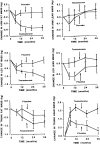Hormone replacement therapy and physical function in healthy older men. Time to talk hormones?
- PMID: 22433122
- PMCID: PMC5393154
- DOI: 10.1210/er.2012-1002
Hormone replacement therapy and physical function in healthy older men. Time to talk hormones?
Abstract
Improving physical function and mobility in a continuously expanding elderly population emerges as a high priority of medicine today. Muscle mass, strength/power, and maximal exercise capacity are major determinants of physical function, and all decline with aging. This contributes to the incidence of frailty and disability observed in older men. Furthermore, it facilitates the accumulation of body fat and development of insulin resistance. Muscle adaptation to exercise is strongly influenced by anabolic endocrine hormones and local load-sensitive autocrine/paracrine growth factors. GH, IGF-I, and testosterone (T) are directly involved in muscle adaptation to exercise because they promote muscle protein synthesis, whereas T and locally expressed IGF-I have been reported to activate muscle stem cells. Although exercise programs improve physical function, in the long-term most older men fail to comply. The GH/IGF-I axis and T levels decline markedly with aging, whereas accumulating evidence supports their indispensable role in maintaining physical function integrity. Several studies have reported that the administration of T improves lean body mass and maximal voluntary strength in healthy older men. On the other hand, most studies have shown that administration of GH alone failed to improve muscle strength despite amelioration of the detrimental somatic changes of aging. Both GH and T are anabolic agents that promote muscle protein synthesis and hypertrophy but work through separate mechanisms, and the combined administration of GH and T, albeit in only a few studies, has resulted in greater efficacy than either hormone alone. Although it is clear that this combined approach is effective, this review concludes that further studies are needed to assess the long-term efficacy and safety of combined hormone replacement therapy in older men before the medical rationale of prescribing hormone replacement therapy for combating the sarcopenia of aging can be established.
Figures







References
-
- 2007. Administration on Aging. Federal Interagency Forum on Aging-Related Statistics. [electronic mail system]. http://www.aoa.gov/AoAroot/Aging_Statistics/Profile/2007/4.aspx
-
- Adams PF , Dey AN , Vickerie JL. 2007. Summary health statistics for the U.S. population: National Health Interview Survey, 2005. Vital Health Stat 10 233:1–104 - PubMed
-
- Nagi SZ. 1965. Rehab in the engineering classroom. Rehabil Rec 6:20–21 - PubMed
-
- Applegate WB , Blass JP , Williams TF. 1990. Instruments for the functional assessment of older patients. N Engl J Med 322:1207–1214 - PubMed
-
- Fried LP , Tangen CM , Walston J , Newman AB , Hirsch C , Gottdiener J , Seeman T , Tracy R , Kop WJ , Burke G , McBurnie MA. 2001. Frailty in older adults: evidence for a phenotype. J Gerontol A Biol Sci Med Sci 56:M146–M156 - PubMed
Publication types
MeSH terms
Substances
Grants and funding
LinkOut - more resources
Full Text Sources
Other Literature Sources
Medical

